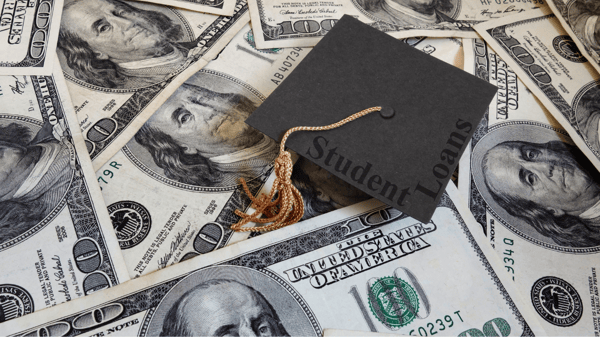The Student Loan Payment Pause Is Over. Now What?
Written by Derek J. Delaney, CFP®, ChFC®, EA, CSLP
Aspen RxHealth is proud to be part of the future of pharmacy, one of the many reasons why they provide clinical pharmacists within their community with resources including a team of professional coaches, like me, to help them make the most of their careers, personal finances, and clinical expertise. As a Certified Financial Planner, my work is dedicated to helping pharmacists plan for their financial future in a way that allows them to create the lives they always wanted. One integral component of future financial success is proactively addressing and planning for student debt repayment.

How we got here
On March 13, 2020, during the onset of COVID-19, eligible student loan payments were paused, and interest rates were set at 0%. This was a welcome reprieve for many borrowers who felt like they were drowning in student loan debt. Unfortunately, we knew it wouldn’t last forever, and in October 2023, millions of student loan borrowers had to resume their payments.
How to handle the return of student loan payments
The best solution is to understand the options available to you and pursue the repayment path that is best for your individual circumstance. Student loan debt and subsequent repayment options are complex and unintuitive, and what you might think is your best option may ultimately be the path that costs you the most. Our goal here is to break down the fundamentals of student loans and provide insight into the appropriate repayment factors you’ll need to consider.
How student loan repayment became a crisis
First, it’s important to highlight why student loan debt is such an issue in America. From 1987 to the present, the cost of tuition rose 500%. A big reason for the debt increase is a slow reduction in state funding for colleges and universities, along with increases in credit which allowed students to borrow more. This, along with an increase in demand for a college education, has led to the rapid increase in education. Fortunately, and unfortunately, this has also resulted in easier access to loans, so much so that the US is approaching $2 trillion in total student loan debt.
And so, in 2023, we’re finding more and more students who’ve taken out significant loans and are struggling with repayment. Pharmacists are no exception. With the level of education required to become licensed, many pharmacists are burdened by high student loan payments. In fact, the average pharmacy school graduate is saddled with over $170,000 in student debt. With interest rates high, many students are merely paying just the interest without addressing principal. If you’ve got student loans that have been on pause up until recently, developing a repayment plan is vital.
Preparing for student loan debt repayment
Step 1: Decide how to tackle the debt
The first step in preparing yourself or a loved one for life as a student loan debtor is to identify how you’ll address the debt. There are four possible options you’ll want to consider:
- Looking into having the debt discharged. This is not an option many can pursue, but it’s not impossible. Student loan debt can be discharged in cases of death, disability, school closures, and fraud.
- Minimize loan interest over time. Borrowers who have an annual income greater than their total student loan debt amount would be wise to pursue this route. These individuals should prioritize expensive loans first and avoid capitalization of any debt.
- For individuals with student loan debt 2 to 3 times higher than their annual income, paying the least amount possible and maximizing your forgiveness is the goal. They have a high debt-to-income ratio and a low future earnings probability. In this case, pursuing long-term student loan forgiveness would be most appropriate. The payment timeline for this outcome is usually 20 or 25 years. Just be aware that, in the end, when your loans are forgiven, there will be a tax consequence you will be required to pay.
- Those who plan to have a career in public service and have a high debt-to-income ratio should look into public service loan forgiveness. Public service loan forgiveness (PSLF) has its own set of rules and requirements to qualify. If this is your goal, you need to make sure you’re following those requirements closely each year.
Step 2: Understanding your loan type and terms
Now that you understand your desired outcome, the next step is to better understand your student loan type and terms. The most common type of student loan today is federal loans. These consist of Perkins, Subsidized, Unsubsidized, GradPLUS, ParentPLUS, and consolidation loans. It’s also not uncommon for a student to accrue two or three different kinds of loans per semester. So, taking an inventory of what type of loans you have will clarify what you can and cannot do with them.
Step 3: Pick a repayment plan
Next, you want to identify which repayment option will work best with your repayment goal and loan type. For many clinical pharmacists, they’ll have the ability to choose from a standard repayment plan, a graduated repayment plan, or an income-driven repayment plan.
A standard repayment plan is amortized over a 10-year period. Each payment will consist of paying back a portion of interest and principal. At the end of the 120th payment, the debt will be paid off. A graduated repayment plan allows for a little more flexibility than a standard plan. Payments will usually start lower at first and increase every 2 years. The graduated repayment plan is not as useful as it used to be since the adoption of income-driven repayment plans.
As the name implies, income-driven repayment plans structure loan repayments based on your annual income. This means the required loan payments you make throughout the year should never become unaffordable since the payment is based on a fixed percentage of your income. You don’t even need to have a job to qualify.
These income-driven repayment plans are why student loan debt is so hard to get discharged in bankruptcy. Since the loan repayment amount is based on your income, the payment should never be the primary factor of your financial burdens. The downside to income-driven repayment plans is that they usually result in negative amortization. This means that the loan balance will likely get larger as you get closer to forgiveness. Even though your monthly payment doesn’t grow, watching the loan balance get higher and higher each year can result in a tremendous amount of stress. But in the end, this is exactly what you want. The bigger your loan balance becomes results in the larger amount of forgiveness awarded in the end.
Financial education and understanding what you owe are just the first step. Developing a solid plan to repay is just as important. As many folks are just starting to factor in repayments and hoping for some relief, having a holistic view of where you stand financially is also part of a solid career plan!
Student loan debt, directly and indirectly, affects everyone. The fastest-growing demographic of individuals who are taking on student loan debt are people aged 50 and older. The solution to the American student loan debt problem starts with better preparation and education. Fortunately, new career options such as Aspen RxHealth are allowing pharmacists to take charge of their earning potential and make extra income. Aspen RxHealth pharmacists have the freedom to:
- Make their own hours
- Choose which patient consultations they complete
- Provide direct patient care
- And use their clinical skills and knowledge to their fullest extent
All from the comfort of home!
Learn more about becoming an Aspen RxHealth pharmacist and get started today
Author:
Derek J. Delaney, CFP®, ChFC®, EA, CSLP
Owner of PharmD Financial Planning
Website: https://pharmdfp.com/
